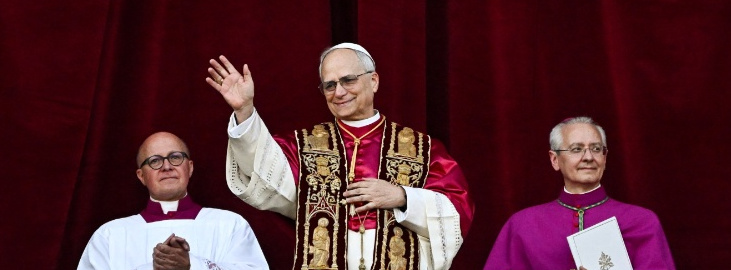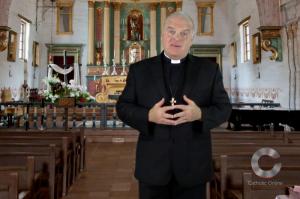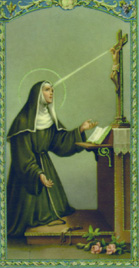SPECIAL: History of the Cross, Scorned and Revered
FREE Catholic Classes
A Professor of Christian art and architecture in Rome considers the history and the meaning of the Cross of Jesus Christ.
Highlights
ROME (Zenit) - What a difference a couple of decades makes! After years of lawsuits demanding that crucifixes be taken down from public places and the banalization of the cross as a fashion accessory or body art, it's no wonder that the feast of the Exaltation of the Cross leaves many people scratching their heads.
The history of the true cross is a long and convoluted one, starting with a shoot from the tree of mercy in Eden, passing through King Solomon's bridge to Jerusalem, to the selection of this aged piece of wood for Christ's crucifixion.Tradition has it that after the crucifixion the cross was hidden.The cross of Christ was rediscovered by St. Helena, the mother of Constantine, who made a pilgrimage to Jerusalem in 326 at the age of 80. Her indomitable spirit, as well as her extraordinary adventures, took their most delightful literary form in Evelyn Waugh's little book "Helena."
Part of the cross stayed in Jerusalem in the Church of the Holy Sepulcher, which was dedicated on Sept. 14, 335. This date would become the feast of the Exaltation, a word that means "raising aloft." The remainder seems to have traveled all over the world. Fragments were sent to Constantine's new churches in Constantinople, while another piece was housed in the Church of the Holy Cross here in Rome, built by St. Helena on her own land.
The devotion to the cross spread so rapidly that before the end of the fourth century the hymn "Flecte genu lignumque Crucis venerabile adora" had been written, and St. John Chrysostom tells us that fragments of the cross were being venerated all over the world.
A king humbled
Oddly enough, however, the Exaltation of the Cross does not only celebrate the rediscovery of the true cross; it also commemorates an event in one of the most turbulent moments of early Christian history.In 615 A.D. on the cusp of the rise of Islam, the Persian army was sweeping through the Mediterranean. King Chosroes of Persia, while leaving the tomb of Christ intact, took the fragment of the cross that Helena had left there.
Setting himself up as god, King Chosroes built a throne in a tall tower where he sat with the cross to his right, calling himself "the father." The Byzantine emperor Heraclius challenged Chosroes to single combat to retrieve the cross. Victorious, Heraclius bore the jeweled reliquary back to Jerusalem. He had planned to bring the relic through the same city gate Christ had entered before his crucifixion, but the stones fell and blocked his passage.
Told that Christ had passed through this gate in humility on a donkey only to suffer death, King Heraclius stripped himself of crown, jewels and shoes, and in his simple tunic took the reliquary upon his shoulders. On Sept. 14, 630, the cross was restored to Jerusalem as an example of humility for all people.This epic captured the imagination of numerous artists, particularly in the Renaissance, when art dedicated itself to recounting only the greatest of stories.Antoniazzo Romano portrayed the event with the jewel-like colors of an illuminated manuscript in the apse of the Church of the Holy Cross, while Piero della Francesca, working in the more remote center of Arezzo from 1452 to 1463, rendered the majesty of this story in one of the most important fresco cycles of the 15th century.
Bearer of peace
In the Franciscan Basilica of San Francesco, Piero tells the story simply and with a minimum of decorative detail, but with powerful monumentality. In one of the earliest night scenes in Italian art -- "Dream of Constantine" -- the emperor sleeps in his tent and dreams of the cross on the eve of the Battle of the Milvian Bridge. A dramatically foreshortened angel erupts into the space along with Piero's lipid light to represent the miracle of Constantine's conversion.Piero's "Exaltation of the Cross," despite the loss of the figure of Heraclius, expresses the peace, calm and order brought with the restoration of the cross -- an appropriate message during his age of constant war.
These images reflect the dignity shown to the cross by artists, citizens and rulers alike.Over the years, the cross has been attacked by more than would-be gods and thieves. Voltaire taught the world to mock the cross when in "The Philosophical Dictionary" he wrote under the heading of Superstition, "Are those pieces of the true cross, which would suffice to build a hundred-gun ship -- are the many relics acknowledged to be false -- are the many false miracles -- so many monuments of an enlightened piety?"
In answer to the scientific age, a group of Jesuits in Belgium, the Bollandists, were formed in the 17th century. They study the evidence relating to miracles, relics and lives of the saints. They cite a study that weighed and measured all the known relics and found that the extant pieces do not make up a single cross.This feast, so often overlooked, has long served the Christian community to remember that the means of our redemption should be brought into the light of our word, lives and hearts at all times, and that we should reflect upon it with the same courage, humility and determination as Jesus showed during his passion.
In today's world, where pop culture derides the cross, and politicians deny the cross, this feast rallies Christians to exalt in Christ's heroic sacrifice, and not to be embarrassed by it.
* * *
Elizabeth Lev teaches Christian art and architecture at Duquesne University's Italian campus. She can be reached at lizlev@zenit.org.
Join the Movement
When you sign up below, you don't just join an email list - you're joining an entire movement for Free world class Catholic education.

Pope Leo XIV – First American Pope
-

- Easter / Lent
- Ascension Day
- 7 Morning Prayers
- Mysteries of the Rosary
- Litany of the Bl. Virgin Mary
- Popular Saints
- Popular Prayers
- Female Saints
- Saint Feast Days by Month
- Stations of the Cross
- St. Francis of Assisi
- St. Michael the Archangel
- The Apostles' Creed
- Unfailing Prayer to St. Anthony
- Pray the Rosary
Three New Venerables: Witnesses of Peace, Martyrdom, and Mission
Childhood Home of Pope Leo XIV Might be Preserved as a Historic Catholic Landmark
Deadly Shooting Outside Jewish Museum Sparks Global Grief and Security Concerns Amid Rising Antisemitism
Daily Catholic
 Daily Readings for Friday, May 23, 2025
Daily Readings for Friday, May 23, 2025 St. John Baptist de Rossi: Saint of the Day for Friday, May 23, 2025
St. John Baptist de Rossi: Saint of the Day for Friday, May 23, 2025 Prayer to St. Gabriel, for Others: Prayer of the Day for Saturday, May 10, 2025
Prayer to St. Gabriel, for Others: Prayer of the Day for Saturday, May 10, 2025 Daily Readings for Thursday, May 22, 2025
Daily Readings for Thursday, May 22, 2025 St. Rita: Saint of the Day for Thursday, May 22, 2025
St. Rita: Saint of the Day for Thursday, May 22, 2025- Prayer for Travelers: Prayer of the Day for Friday, May 09, 2025
![]()
Copyright 2025 Catholic Online. All materials contained on this site, whether written, audible or visual are the exclusive property of Catholic Online and are protected under U.S. and International copyright laws, © Copyright 2025 Catholic Online. Any unauthorized use, without prior written consent of Catholic Online is strictly forbidden and prohibited.
Catholic Online is a Project of Your Catholic Voice Foundation, a Not-for-Profit Corporation. Your Catholic Voice Foundation has been granted a recognition of tax exemption under Section 501(c)(3) of the Internal Revenue Code. Federal Tax Identification Number: 81-0596847. Your gift is tax-deductible as allowed by law.



 Daily Readings for Friday, May 23, 2025
Daily Readings for Friday, May 23, 2025 St. John Baptist de Rossi: Saint of the Day for Friday, May 23, 2025
St. John Baptist de Rossi: Saint of the Day for Friday, May 23, 2025 Prayer to St. Gabriel, for Others: Prayer of the Day for Saturday, May 10, 2025
Prayer to St. Gabriel, for Others: Prayer of the Day for Saturday, May 10, 2025 St. Rita: Saint of the Day for Thursday, May 22, 2025
St. Rita: Saint of the Day for Thursday, May 22, 2025


